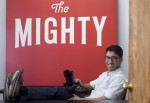Nerris Nassiri walked the streets of Los Angeles from Koreatown to Little Ethiopia, collecting stories of the diverse communities for his senior thesis.
Walking the crowded streets of Little India was a woman who had moved from India to Los Angeles with her three children. She spoke of family life, raising her children and opening up her own store, Nassiri said.
Nassiri aimed to humanize the different ethnic communities in his experimental 2015 documentary film “Enclaves,” inspired by his Middle Eastern and Latino background. He said the interviews he conducted captured the work and family life of people who may not have the opportunity to share their stories.
“That was essentially telling the story of underdogs,” he said.
The film, television and digital media alumnus continues to help voice the less-told stories in his work as a video producer at The Mighty. The online publication uses content written by people with mental or physical disabilities. Nassiri said telling the stories of real-life people has changed his approach to filmmaking and increased his knowledge about the lives of his subjects.
[Related: Theater meets psychiatry in play about mental illness and ‘Friends’]
Nassiri’s job includes all aspects of the filmmaking process. Any day he could conduct a Facebook livestream in the morning with someone who has anxiety, hold a photo shoot for a model who has Down syndrome in the afternoon and then edit a short film on suicide prevention in the evening, he said.
The fast-paced style of working at a startup of around 20 people has fit Nassiri’s work ethic since his days at UCLA, said Rafe Blood, his friend and former classmate.
Blood and Nassiri worked together on several projects while in college. Blood said the hands-on role that Nassiri took as a producer was unusual for a position that is typically more passive on the day of the actual shoot. If Blood needed someone to pick up an actor and bring them to set, Nassiri would already be in his car driving to their house.
“He’ll do whatever he needs to do to get it done as quickly as possible,” Blood said.
For Nassiri, he said since all the videos produced at The Mighty feature real-life people rather than hired actors, they presented a new challenge. A real-life person sharing their story tends to be more timid in front of a production crew, he said.
“I have found that for filming, the less gear you have the better,” he said.
Nassiri eases the fear of the participants by first talking to them about their families, mental health news and sometimes politics. He gets to know the person and their experiences before bringing out the camera equipment, a technique that he wishes he would have known when filming for his senior thesis.
“I wish I would have gotten to know the person and just talked to them for a long time before even talking about the documentary project that I had,” Nassiri said.
[Related: Tattoos relate mental health stories in art exhibition]
Sarah Schuster, mental health editor at The Mighty, worked with Nassiri to turn one of her submissions into a film. She wrote the piece in college to reflect on her anxiety and how she pretended to go to the gym when she was seeking counseling, she said.
“While I was pretty uncomfortable talking about my own mental health, one way that I was talking about it was through writing,” she said.
When Schuster acted in the film, Nassiri asked her to think about a time when she was going through a similar situation, instead of telling her where to look or what to do. His questions drew out her natural movements and emotions, she said.
Nassiri said his personal interactions with his subjects have led him to become more knowledgeable about the mental health community.
UCLA alumnus Andy Truong, who is working toward becoming a physician, saw this as a chance for him to learn about mental health from his friend.
“He’s the one who taught me a lot when it came to mental illness,” Truong said. “It was a fusion of our worlds in a sense.”
The knowledge of the ailments that other people face has brought out a new sense of empathy in Nassiri, he said.
“Having worked with so many people with disabilities and depression and all kinds of invisible conditions, you really learn how to look at people a new way,” Nassiri said. “You learn how to look at a person as a person first.”
